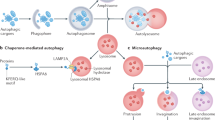Abstract
Autophagy is an intracellular protein degradation pathway that plays a vital role in cellular homeostasis. It maintains cellular function through proteostasis and the removal of unused and harmful proteins and organelles. Moreover, it also serves as an adaptive response to metabolic perturbations. Deviation in autophagy activity has been linked to the progression of several pathologies, including neurodegenerative diseases. Preclinical trials have shown that modulating autophagy holds great promise in treating neurodegenerative diseases by clearing toxic protein aggregates. The success of autophagy modulating therapies requires extensive knowledge of the molecular machinery and, importantly, an in-depth understanding of the underlying systems properties of the autophagy system. A computational approach provides a powerful platform to interrogate and analyze the regulation, control, and behavior of reaction networks. However, the complexity of interactions involved in the autophagy pathway makes it challenging to isolate and characterize individual components. By reducing the autophagy process to a supply-demand system in which autophagosome synthesis (supply) and autophagosome degradation (demand) are linked by the autophagosomes, it is possible to determine the control of the supply and demand over the steady-state autophagosome flux and autophagosome concentration. In this chapter, we describe a methodology to perform supply and demand analysis of the autophagy system, the experimental procedure to measure the autophagy variables, and the use of the supply-demand framework to determine the distribution of flux and concentration control.
Access this chapter
Tax calculation will be finalised at checkout
Purchases are for personal use only
Similar content being viewed by others
References
Börlin CS, Lang V, Hamacher-Brady A, Brady NR (2014) Agent-based modeling of autophagy reveals emergent regulatory behavior of spatio-temporal autophagy dynamics. Cell Commun Signal 12, 56
Carpi N, Piel M, Azioune A, Fink J (2011) Micropatterning on glass with deep uv. Nat Protocol Exch 10
Du Toit A, De Wet S, Hofmeyr J-H, Müller-Nedebock K, Loos B (2018) The precision control of autophagic flux and vesicle dynamics–a micropattern approach. Cells 7:94
du Toit A, Hofmeyr J-HS, Gniadek TJ, Loos B (2018) Measuring autophagosome flux. Autophagy 14:1060–1071. PMID: 29909716
Han K, Kwon HW, Kang H, Kim J, Lee M-S, Choi M (2012) Dynamics of macroautophagy: modeling and oscillatory behavior. Physica A 391:686–692
Han K, Kim J, Choi M (2014) Computer simulations unveil the dynamics of autophagy and its implications for the cellular quality control. J Biol Syst 22:659–675
Han K, Kim J, Choi M (2014) Quantitative indices of autophagy activity from minimal models. Theor Biol Med Model 11:31
Hofmeyr J-HS, Cornish-Bowden A (1996) Co-response analysis: a new experimental strategy for metabolic control analysis. J Theor Biol 182:371–380
Hofmeyr J-HS, Cornish-Bowden A (2000) Regulating the cellular economy of supply and demand. FEBS Lett 476:47–51
Kapuy O, Vinod PK, Mandl J, Bánhegyi G (2013) A cellular stress-directed bistable switch controls the crosstalk between autophagy and apoptosis. Mol BioSyst 9:296–306
Kuma A, Mizushima N (2010) Physiological role of autophagy as an intracellular recycling system: with an emphasis on nutrient metabolism. Semin Cell Dev Biol 21:683–690
Loos B, Engelbrecht A-M, Lockshin RA, Klionsky DJ, Zakeri Z (2013) The variability of autophagy and cell death susceptibility: Unanswered questions. Autophagy 9:1270–1285
Loos B, du Toit A, Hofmeyr J-HS (2014) Defining and measuring autophagosome flux–concept and reality. Autophagy 10:2087–2096
Martin KR, Barua D, Kauffman AL, Westrate LM, Posner RG, Hlavacek WS, MacKeigan JP (2013) Computational model for autophagic vesicle dynamics in single cells. Autophagy 9:74–92
Mathew R, Karantza-Wadsworth V, White E (2007) Role of autophagy in cancer. Nat Rev Cancer 7:961–967
Mizushima N, Yoshimori T, Levine B (2010) Methods in mammalian autophagy research. Cell 140:313–326
Ravikumar B, Vacher C, Berger Z, Davies JE, Luo S, Oroz LG, Scaravilli F, Easton DF, Duden R, O’Kane CJ, Rubinsztein DC (2004) Inhibition of mTOR induces autophagy and reduces toxicity of polyglutamine expansions in fly and mouse models of Huntington disease. Nat Genet 36:585–595
Son JH, Shim JH, Kim K-H, Ha J-Y, Han JY (2012) Neuronal autophagy and neurodegenerative diseases. Exp Mol Med 44:89–98
Tavassoly I, Parmar J, Shajahan-Haq A, Clarke R, Baumann W, Tyson J (2015) Dynamic modeling of the interaction between autophagy and apoptosis in mammalian cells. CPT: Pharmacometrics Syst Pharmacol 4:263–272
Acknowledgements
We acknowledge financial support from the South African National Research Foundation (NRF), the South African Medical Research Council (SAMRC) as well as the Cancer Association of South Africa (CANSA). All microscopy work was performed at the Central Analytical Facility (CAF), Cell Imaging Unit, Stellenbosch University, South Africa.
Author information
Authors and Affiliations
Corresponding author
Editor information
Editors and Affiliations
Rights and permissions
Copyright information
© 2020 Springer Science+Business Media, LLC, part of Springer Nature
About this protocol
Cite this protocol
Toit, A.d., Loos, B., Hofmeyr, J.H.S. (2020). Supply and Demand Analysis of Autophagy. In: Nagrath, D. (eds) Metabolic Flux Analysis in Eukaryotic Cells. Methods in Molecular Biology, vol 2088. Humana, New York, NY. https://doi.org/10.1007/978-1-0716-0159-4_16
Download citation
DOI: https://doi.org/10.1007/978-1-0716-0159-4_16
Published:
Publisher Name: Humana, New York, NY
Print ISBN: 978-1-0716-0158-7
Online ISBN: 978-1-0716-0159-4
eBook Packages: Springer Protocols




